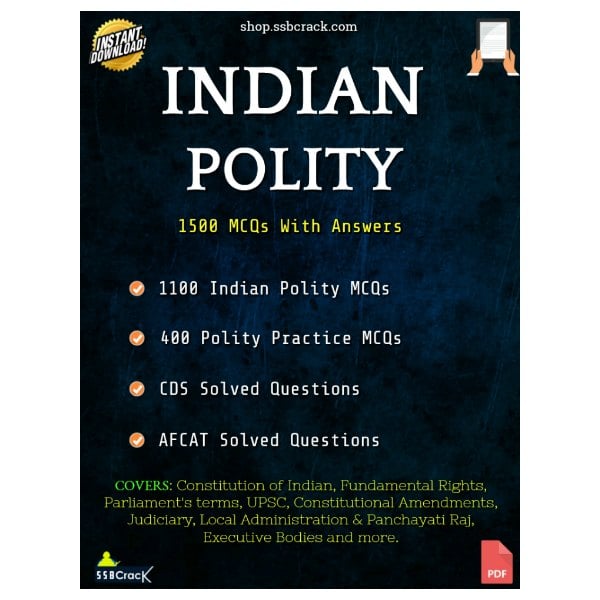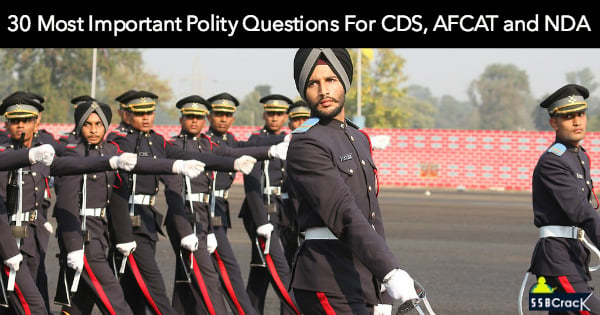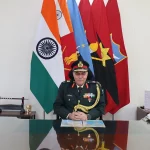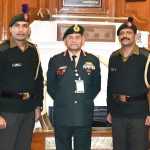Candidates who are preparing the Polity subject for the various competitive exams like CDS, NDA, AFCAT, SSC, UPSC, Banking and more can check the latest Politics questions and answers below. You can also download the Polity ebook for the competitive exam preparation which has Polity notes and questions with complete explanations. Here are few important Indian polity questions for competitive exams like CDS, AFCAT and NDA. Also, you might face this questions during SSB interview.
 30 Most Important Polity Questions
30 Most Important Polity Questions
Q1. The system of judicial review originated in
(a) Germany
(b) India
(c) Russia
(d) U.S.A.
Explanation: (d). Judicial review is the doctrine under which legislative & executive actions are subject to review (and possible invalidation) by the judiciary. It is an example of the separation of powers in a modern governmental system (where the judiciary is one of three branches of government). Is is one of the main characteristics of government in the Republic of the United States. In the United States, federal & state courts (at all levels, both appellate & trial) are able to review & declare the “constitutionality”, or agreement with the Constitution (or lack there of) of legislation that is relevant to any case properly within their jurisdiction. In American legal language, “judicial review” refers primarily to the adjudication of constitutionality of statutes, especially by the Supreme Court of the United States.
Q2. Which of the given legislation gives constitutional status to three-tier Panchayati Raj system –
(a) 73rd constitutional amendment, 1993
(b) 72nd constitutional amendment, 1992
(c) 74th constitutional amendment, 1993
(d) 75th constitutional amendment, 1994
Explanation: (a) 73rd constitutional amendment, 1993.The philosophy of Panchayat Raj is deeply steeped in tradition & culture of rural India & is by no means a new concept. April 24,1993 is a red letter day in the history of Panchayati Raj in India as on this day the constitution (73rd Amendment) Act,1992 came into force to provide constitutional status to the Panchayati Raj institutions. Panchayati Raj provided a system of self-governance at the village level, however, it did not have a constitutional status.
Q3. Under which among the given circumstances, the Governor can reserve a state bill for the consideration of the President –
1. If it is ultra vires.
2. It is opposed to the Directive Principles of State Policy.
3. If it endangers the position of the state High Court.
4. If it is dealing with the compulsory acquisition of property under Article 31 – A.
(a) 1, 2, 3 & 4
(b) 1, 2 & 3
(c) 2, 3 & 4
(d) 1, 3 & 4 State Govt.
Ans: (a)
Q4. One of the following is not the function of the municipalities under 74th Amendment
(a) Economic and social planning
(b) Construction of buildings
(c) Water supply
(d) Fisheries
Ans: (d)
Q5. How does the Constitution of India describe India as –
(a) A Union of States
(b) A federation of States & Union Areas
(c) Bharatvarsh
(d) A federated nation
Explanation: (a) A Union of States.With its adoption, the Union of India officially became the modern & contemporary Republic of India & it replaced the Government of India Act 1935 as the country’s fundamental governing document. The Constitution declares India to be a sovereign, socialist, secular, democratic republic, assuring its citizens of justice, equality, & liberty, & endeavours to promote fraternity among them.
Q6. The 1st State in India to implement Panchayati Raj System was
(a) Rajasthan
(b) Punjab
(c) Gujarat
(d) Uttar Pradesh
Explanation: (a) Rajasthan.In October 1957, the Balwant Rai Mehta committee suggested the organization of Panchayati Raj in rural India. The National Development council accepted the recommendations of Balwant Rai Mehta committee in 1958. It recommended the creation of the three tier Panchayati Raj- Panchayats at the village level, Panchayat Samities at the block level & Zila Parishads at the district level. On October 2, 1959, Rajasthan became the 1st State to establish Panchayati Raj system. Thereafter, Andhra Pradesh, Punjab, West Bengal, Gujarat, Madhya Pradesh, Orissa, Bihar, Kerala, J & K, Himachal Pradesh & in fact all states introduced Panchayati Raj in their respective areas by passing necessary laws.
Q7. While appointing a Lokayuka, the Governor in most of the states consults:
1. President of India
2. Speaker of the Legislative Assembly
3. Leader of the opposition in the Legislative Assembly
4. Chief justice of the State High Court.
5. Leader of the Opposition in the Legislative Council.
(a) 1, 2 & 4
(b) 1, 4 & 5
(c) 3, 4 & 5
(d) 3 & 4
Ans: (d)
Q8. Which of the following article empowers the President to call for joint sitting of both houses?
(a) Art 102
(b) Art 101
(c) Art 108
(d) Art 110
Ans: (c)
Q9. Which among the given exercised the most profound influence in framing the Indian Constitution –
(a) US Constitution
(b) British Constitution
(c) Irish Constitution
(d) The Government of India Act, 1935
Explanation: (d). The most profound influence was exercised by the Government of India Act of 1935. Such features as the federal scheme, office of governor, power of federal judiciary, emergency powers etc were drawn from this Act. The British practice influenced the lawmaking procedures, rule of law, system of single citizenship, besides, of course, the model of a parliamentary government. The US Constitution inspired details on the independence of judiciary, judicial review, fundamental rights, & the removal of Supreme Court & High Court judges. The Irish Constitution was the source of the Directive Principles, method of Presidential elections, & the nomination of members of Rajya Sabha by the President.
Q10. Which among the given is not an administrative function of a Village Panchayat –
(a) Providing burial & cremation grounds
(b) Providing sanitation & drainage
(c) Providing college education
(d) Maintenance of roa
Explanation: (c) Providing college education.Some of the functions of a Gram Panchayat are: collection of taxes like house etc; promotion of educational, health, agriculture & communication facilities; providing health & drinking water facilities whenever the village people need; produce authentic documents regarding birth, death or property details of village people; look after general welfare & immediate development of village e. road, fight, bazaar, community facilities, etc.g.
Q11. The true statements about ordinance making power of the Governor are:
1. It is laid down in Article 213.
2. It can be issued by him after the advice of the president of state council of ministers.
3. It is co-extensive with the legislative power of the state legislature.
4. It can be issued only during the recess of State Legislative Assembly & not the Legislative Council.
5. It can not be withdrawn by him anytime.
(a) 1, 3 & 5
(b) 2, 3 & 4
(c) 1, 2 & 3
(d) 2, 4 & 5
Ans: (c)
Q12. One of the following is not an urban local body :
(a) town area committee
(b) municipalities
(c) samitis
(d) notified area committee
Ans: (c)
Q13. A federal structure for India was 1st put forward by the:
(a) Act of 1919
(b) Act of 1909
(c) Act of 1935
(d) Act of 1947
Explanation: (c) Act of 1935.The Government of India Act 1935, the voluminous & final constitutional effort at governing British India, articulated three major goals: establishing a loose federal structure, attaining provincial autonomy, & safeguarding minority interests through separate electorates. In February 1937, however, provincial autonomy became a reality when elections were held. The federal provisions, intended to unite princely states & British India at the centre, were not implemented as of ambiguities in safeguarding the existing privileges of princes.
Q14. The Committee appointed in 1977 to review working of the Panchayati Raj was chaired by:
(a) Ashok Mehta
(b) Balwant Rai Mehta
(c) K. N. Katju
(d) Jagjivan Ram
Explanation: (a) Ashok Mehta.In December 1977, the Janata Government appointed a committee on Panchayati Raj institutions under the chairmanship of Ashok Mehta. As a result of this report, the Indian states of Karnataka, Andhra Pradesh, & West Bengal passed new legislation. The committee submitted its report in August 1978 & made 132 recommendations to revive & strengthen the declining Panchayati Raj system in the country.
Q15. Which among the given are the discretionary powers given to the Governor of a State –
1. Sending a report to the President of India for imposing the President’s rule
2. Appointing the Ministers
3. Reserving certain bills passed by the State Legislature for consideration of the President of India
4. Making the rules to conduct the business of the State Govt. Select the true answer using the code given below.
(a) 1 & 3 only
(b) 1 & 2 only
(c) 2, 3 & 4 only
(d) 1, 2, 3 & 4
Ans: (a)
Q16. Under which article are the Council of Ministers collectively responsible to Parliament?
(a) Art 74 (c)
(b) Art 75 (c)
(c) Art 73 (b)
(d) Art 72 (b)
Ans: (b)
Q17. Charles Correa is a renowned Indian
(a) Painter
(b) Freedom fighter
(c) Architect, urban planner
(d) Award winning doctor
Explanation: Charles Correa was an Indian architect, urban planner & activist. He was chiefly responsible for the planning of township of Navi Mumbai in the 1970s. Credited for the creation of modern architecture in post-Independence India, he was described as “India’s greatest architect”. 1.
Q18. All doubts & disputes in connection with election of the President are inquired into & decided by __________.
(a) the Supreme Court
(b) the Election Commission
(c) the Parliament
(d) Prime Minister
Explanation: (a) the Supreme Court.According to Article 71 of the Constitution, all doubts & disputes arising out of or in connection with the election of a President or Vice-President shall be inquired into & decided by the Supreme Court. I If the election is declared void by the Supreme Court, acts done by him in the exercise & performance of the powers & duties of the office, on or before the date of the decision of the Supreme Court shall not be invalidated by reason of that declaration.
Q19. Article 156 of the Constitution of India provides that a Governor shall hold office for a term of 5 years from the date on which he enters upon his office. Which among the given can be deducted from this –
1. No Governor can be removed from office till the completion of his term.
2. No Governor can continue in office beyond a period of five years. Which among the given statements is/are correct –
(a) 2 only
(b) 1 only
(c) Both 1 & 2
(d) Neither
Ans: (d)
Q20. Consider the following statements: ________
1. National Policy on Education envisages a common educational structure which is 10+2+1+3 ________
2. It promotes values such as emphasis on common cultural heritage, secularism and the like ________ Which of the statements given above is/are correct?
(a) 2 only
(b) 1 only
(c) Both 1 and 2
(d) Neither 1 nor 2
Ans: (a)
Q21. Who among the following was the Chairman of the Drafting Committee of the Constitution –
(a) Rajendra Prasad
(b) J. B. Kripalani
(c) J. L. Nehru
(d) B. R. Ambedkar
Explanation: (d)., Alladi Krishnaswamy Iyer (ExAdvocate General, Madras State), N Gopalaswami Ayengar (Ex-Prime Minister, J&K & later member of Nehru Cabinet), B L Mitter (Ex-Advocate General, India), Md. Saadullah (Ex- Chief Minister of Assam, Muslim League member) & D P Khaitan (Scion of Khaitan Business family & a renowned lawyer). The constitutional advisor was Sir Benegal Narsing Rau (who became 1st Indian Judge in International Court of Justice, 1950–54).
Q22. Which among the given is not a Panchayati Raj Institution –
(a) Gram Panchayat
(b) Gram Sabha
(c) Gram Cooperative Society
(d) Nyaya Panchayat
Explanation: (c) Gram Cooperative Society. Cooperative is an autonomous association of persons who voluntarily cooperate for their mutual social, economic, & cultural benefit. The Panchayati Raj Institutions (PRIs) in India are Zilla Panchayat; Block Panchayat or Panchayat Samiti; Gram Panchayat; Gram Sabha Cooperatives include non-profit community organizations & businesses that are owned & managed by the people who use its services (a consumer cooperative) and/or by the people who work there (a worker cooperative) or by the people who live there (a housing cooperative).
Q23. In which among the given bodies, does the Chief Minister of a State hold membership –
1. National Integration Council
2. National Development Council
3. Inter-State Council
4. Zonal Council Select the true answer from the codes given below:
(a) 2 & 3
(b) 1, 3 & 4
(c) 1, 2, 3 & 4
(d) 2, 3 & 4
Ans: (c)
Q24. The National Policy on Agriculture (2000) does not include one of the following:
(a) To promote safety, health and conducive environment at farms and fields
(b) To minimize fluctuations in commodity prices
(c) To provide adequate and timely supply of quality inputs
(d) To seek rational utilization of water resources
Ans: (a)
Q25. Who among the given was not a member of the Constituent Assembly established in July 1946 –
(a) K M Munshi
(b) Dr. Rajendra Prasad
(c) Mahatma Gandhi
(d) Abul Kalam Azad
Explanation: (c) Mahatma Gandhi.The Constituent Assembly of India was elected to write the Constitution of India.B. Some of its main members were Pandit Jawaharlal Nehru, Maulana Abul Kalam Azad, Sardar Vallabhbhai Patel, Acharya J. Kriplani, Dr. Rajendra Prasad, Smt. Sarojini Naidu, Shri Hare-Krushna Mahatab, Pandit Govind Ballabh Pant, Dr. B.R. Ambedkar, Shri Sarat Chandra Bose, Shri C. Rajagopalachari & Shri M. Asaf Ali.
Q26. The 3-tier of the Panchayati Raj System consists of
(a) Janapad Panchayat, Taluka Panchayat, Anchal Panchayat
(b) Gram Sabha, Anchal Panchayat, Panchayat Samiti
(c) Gram Panchayat, Block & Panchayat Samiti, Zilla Parishad
(d) Gram Sabha, Panchayat Samiti, Zilla Parishad
Explanation: (d). Panchayati Raj is a system of governance in which gram panchayats are the basic units of administration. It has 3 levels: village, block & district. At the village level, it is called a Gram Panchayat. It is a local body working for the good of the village. The number of members usually ranges from 7 to 31; occasionally, groups are larger, but they never have fewer than 7 members. The block-level institution is called the Panchayat Samiti. The district- level institution is called the Zilla Parishad.
Q27. Consider the following statements: The Governor of a State has the power to appoint:
1. Judges of the High Court
2. Members of the State Public Service Commission
3. Members of the State Finance Commission
4. The Accountant General Which of the following of these statements are correct –
(a) 2 & 3
(b) 1 & 2
(c) 1, 3 & 4
(d) 1, 2, 3 & 4
Explanation: (a) The Governor has the power to appoint the Council of Ministers including the Chief Minister of the state, the Advocate General & the members of the State Public Service Commission. However, the Governor cannot remove the members of the State Public Service Commission as they can only be removed by an order of the President.
Q28. One of the following is wrongly listed:
(a) National Policy on: 1990 Education
(b) National Policy on: 2000 Agriculture
(c) National Policy on Health : 2009 Safety and Environment at work place
(d) National Youth Policy: 2003
Ans: (a)
Q29. From the Constitution of which country the provision of Federation was borrowed while framing the Constitution of India –
(a) UK
(b) USA
(c) Canada
(d) Switzerland
Explanation: (c) Canada.Though the basic features of Indian Constitution are based on the Government of India Act, 1935, it has many features which were borrowed from many other constitutions. It was from the Canadian Constitution that India borrowed a quasi-federal form of government (a federal system with a strong central government) & the idea of Residual Powers.
Q30. The Balwant Rai Mehta Committee was related with—
(a) Banking Reforms
(b) Industrial Policy
(c) Panchayati Raj
(d) Center-State relations
Explanation: (c) Panchayati Raj.The Balwant Rai Mehta Committee was a committee appointed by the Government of India in January 1957 to examine the working of the Community Development Programme (1952) & the National Extension Service (1953) & to suggest measures for their better working. The committee submitted its report in November 1957 & recommended the establishment of the scheme of ‘democratic decentralization’ which finally came to be known as Panchayati Raj. The Chairman of this committee was Balwant Rai Mehta.
To crack the AFSB and SSB interview, we recommend you to get “Let’s Crack SSB Interview” book from Amazon.
Download eBooks:
Read More













